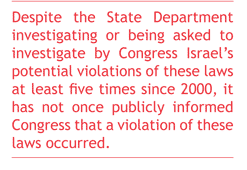Executive Summary
From 1949 to 2008, the U.S. government provided Israel more than $103.6 billion of total official aid, making it the largest recipient of U.S. foreign assistance in the post-World War II era.� In 2007, the two countries signed a Memorandum of Understanding providing for $30 billion of U.S. military aid from 2009 to 2018.
Between FY2000 and 2009, the United States gave Israel $24.1 billion of military aid.� With this taxpayer money, the United States licensed, paid for and delivered more than 670 million weapons and related equipment to Israel, including almost 500 categories of weapons.� During roughly the same period (September 29, 2000, to December 31, 2009), Israel killed at least 2,969 unarmed Palestinians in the West Bank, East Jerusalem and Gaza Strip. Often Israel killed these Palestinians with many of the types of weapons provided with U.S. military aid. �This paper presents case studies of how U.S.-supplied tear gas, bulldozers and white phosphorous were used by Israel to commit human rights abuses of Palestinians. �Israel also employed U.S. weapons to commit additional human rights abuses of Palestinians, including, but not limited to, the injuring of tens of thousands of Palestinian civilians since 2000, the deliberate destruction of Palestinian civilian infrastructure, the denial of Palestinians' right to freedom of movement, and the construction of Israeli settlements on expropriated Palestinian land.

Strong evidence exists showing that Israel's misuse of U.S. weapons to commit human rights abuses of Palestinians in furtherance of its 44-year military occupation of the West Bank, East Jerusalem and Gaza Strip violates U.S. laws, including the Foreign Assistance Act and Arms Export Control Act.� In the past, numerous countries, including Israel, have had U.S. foreign assistance programs withheld, conditioned, or cut off for violating these laws.� Despite the State Department investigating or being asked to investigate by Congress Israel's potential violations of these laws at least five times since 2000, it has not once publicly informed Congress that a violation of these laws occurred.� Israel should not be held to a different standard than other countries, and this situation should be addressed without fail.
In addition to these legal implications, ever-expanding amounts of military aid to Israel function as a disincentive for Israel to take seriously U.S. foreign policy objectives.� They also crowd out other budgetary priorities for unmet domestic needs in a time of economic crisis, have a diminishing strategic rationale, and are being challenged by more Israelis who worry about the strategic, economic, and political ramifications of relying on U.S. military aid.
As a step toward ending U.S. military aid to Israel, this paper concludes with specific policy recommendations for Congress and the President to condition U.S. military aid to Israel to achieve stated U.S. policy goals of freezing settlement growth, easing the blockade of the Gaza Strip, ending the human rights abuses associated with Israel's military occupation of the Palestinian West Bank, East Jerusalem and Gaza Strip, and establishing a just and lasting Israeli-Palestinian peace.
Sites we love
- Non Aams Casino
- Non Gamstop Casinos
- Betting Sites
- Casinos Not On Gamstop
- Casino Not On Gamstop
- Best Online Casino Canada
- Non Gamstop Casino
- Non Gamstop Casino UK
- Non Gamstop Casino UK
- Non Gamstop Casino Sites UK
- Casino En Ligne France
- UK Non Gamstop Betting Sites
- Non Gamstop Casino Sites UK
- Gambling Sites Not On Gamstop
- Non Gamstop Casino Sites UK
- Casino Non Aams
- Non Gamstop Casino Sites UK
- UK Casino Not On Gamstop
- Casino Sites Not On Gamstop
- Best Casino Slot Sites
- UK Casino Not On Gamstop
- Migliori Casino Online Non Aams

